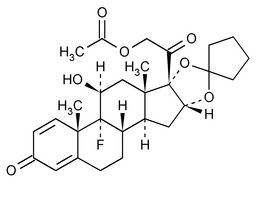Amcinonide
(am sin' oh nide).
Pregna-1,4-diene-3,20-dione, 21-(acetyloxy)-16,17-[cyclopentylidenebis(oxy)]-9-fluoro-11-hydroxy-, (11
9-Fluoro-11
» Amcinonide contains not less than 97.0 percent and not more than 102.0 percent of C28H35FO7, calculated on the dried basis.
Packaging and storage—
Preserve in well-closed containers.
Identification—
B:
Ultraviolet Absorption  197U
197U —
—
Solution:
40 µg per mL.
Medium:
methanol.
Absorptivities at 238 nm, calculated on the dried basis, do not differ by more than 3.0%.
Loss on drying  731
731 —
Dry it at 105
—
Dry it at 105 for 4 hours: it loses not more than 1.0% of its weight.
for 4 hours: it loses not more than 1.0% of its weight.
Heavy metals, Method II  231
231 :
0.002%.
:
0.002%.
Assay—
Solution A—
Prepare a filtered and degassed mixture of water and acetonitrile (13:7).
Solution B—
Prepare a filtered and degassed mixture of acetonitrile and water (7:3).
Mobile phase—
Use variable mixtures of Solution A and Solution B as directed for Chromatographic system. Make adjustments to either Solution as necessary (see System Suitability under Chromatography  621
621 ).
).
System suitability solution—
Dissolve suitable quantities of butylparaben and USP Amcinonide RS in Solution B to obtain separate solutions containing 12.5 µg per mL and 20 µg per mL, respectively.
Standard preparation—
Dissolve an accurately weighed quantity of USP Amcinonide RS in Solution B, and dilute quantitatively, and stepwise if necessary, with Solution B to obtain a solution having a known concentration of about 0.02 mg per mL.
Assay preparation—
Transfer about 20 mg of Amcinonide, accurately weighed, to a 100-mL volumetric flask, dissolve in and dilute with Solution B to volume, sonicate for 5 minutes, and mix. Transfer 5 mL of this solution to a 50-mL volumetric flask, dilute with Solution B to volume, and mix.
Chromatographic system
(see Chromatography  621
621 )—The liquid chromatograph is equipped with a 254-nm detector and a 4.6-mm × 25-cm column that contains packing L1, and is programmed to provide variable mixtures of Solution A and Solution B. The flow rate is about 2 mL per minute. Equilibrate the system with Solution A. From 2.5 minutes to 10 minutes after injection, linearly increase the amount of Solution B to 100%. Chromatograph the System suitability solution, and record the peak responses as directed under Procedure: the relative retention times are about 0.78 for butylparaben and 1.0 for amcinonide, and the resolution, R, between butylparaben and amcinonide is not less than 8.0. Chromatograph the Standard preparation, and record the peak responses as directed for Procedure: the tailing factor is not more than 1.5, and the relative standard deviation for replicate injections is not more than 2.0%.
)—The liquid chromatograph is equipped with a 254-nm detector and a 4.6-mm × 25-cm column that contains packing L1, and is programmed to provide variable mixtures of Solution A and Solution B. The flow rate is about 2 mL per minute. Equilibrate the system with Solution A. From 2.5 minutes to 10 minutes after injection, linearly increase the amount of Solution B to 100%. Chromatograph the System suitability solution, and record the peak responses as directed under Procedure: the relative retention times are about 0.78 for butylparaben and 1.0 for amcinonide, and the resolution, R, between butylparaben and amcinonide is not less than 8.0. Chromatograph the Standard preparation, and record the peak responses as directed for Procedure: the tailing factor is not more than 1.5, and the relative standard deviation for replicate injections is not more than 2.0%.
Procedure—
Separately inject equal volumes (about 10 µL) of the Standard preparation and the Assay preparation. Record the chromatograms, and measure the responses for the major peaks. Calculate the quantity, in mg, of C28H35FO7 in the portion of Amcinonide taken by the formula:
1000C(rU / rS)
in which C is the concentration, in mg per mL, of USP Amcinonide RS in the Standard preparation; and rU and rS are the peak responses obtained from the Assay preparation and the Standard preparation, respectively.
Auxiliary Information—
Please check for your question in the FAQs before contacting USP.
| Topic/Question | Contact | Expert Committee |
|---|---|---|
| Monograph | Domenick Vicchio, Ph.D.
Senior Scientific Liaison 1-301-998-6828 |
(SM42010) Monographs - Small Molecules 4 |
| Reference Standards | RS Technical Services 1-301-816-8129 rstech@usp.org |
USP35–NF30 Page 2155

